



See The Ladies' Home Journal war drawing below in the third issue of
 Frank
E. Schoonover was born in 1877 in New Jersey. It was the perfect
time and the perfect place. In 1896, he was accepted to the Drexel
Institute in Philadelphia, where Howard
Pyle was teaching illustration one day a week. In 1897, the
course was divided into two parts, with Pyle teaching the advanced
students. Schoonover was one of the fortunate ones who "graduated"
to the Pyle class. Others were Maxfield
Parrish, Jessie Willcox
Smith, Violet and Thornton Oakley, and Stanley M. Arthurs.
Frank
E. Schoonover was born in 1877 in New Jersey. It was the perfect
time and the perfect place. In 1896, he was accepted to the Drexel
Institute in Philadelphia, where Howard
Pyle was teaching illustration one day a week. In 1897, the
course was divided into two parts, with Pyle teaching the advanced
students. Schoonover was one of the fortunate ones who "graduated"
to the Pyle class. Others were Maxfield
Parrish, Jessie Willcox
Smith, Violet and Thornton Oakley, and Stanley M. Arthurs.
Schoonover was not an immediate success. He was mainly self-taught and had been planning to become a minister when he saw the Drexel ad for the Illustration Class. Despite his lack of technical skills, Pyle saw his raw brilliance and encouraged him to audit classes. Stuck in the rear of the classrooms, he and Arthurs became fast life-long friends and, oddly enough, both became friends and confidants of Pyle (that's Pyle and Frank at left - I cropped Stanley out of the picture). Schoonover improved quickly and he was proficient enough to win one of the ten prized scholarships to the Chadds Ford Summer classes in 1898 and 1899. There Pyle tutored the most developed students and the class size was limited. Entrance by means of one of the scholarships was very prestigious. By the second year, Pyle had secured work for Schoonover and he was illustrating books: A Jersey Boy of the Revolution and In the Hands of the Red Coats, both in 1899.
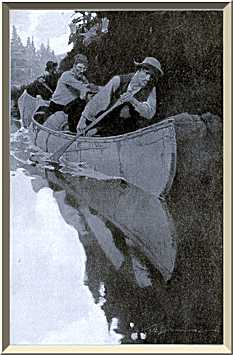 Pyle
resigned from Drexel in 1900 and built his own school next
to his studio. Schoonover (and Arthurs) came along. The excursions
to Chadds Ford on the Brandywine River continued. Schoonover relished
the outdoor experiences. He had been attracted to the fields and
streams as a young boy and some of his earliest memories and drawings
were of those subjects. Pyle's tutelage reinforced that bent and
his earliest commissions were for outdoor adventure stories like
In The Open by Mary Raymond Shipman Andrews (at
right) from the July 1903 issue of Scribner's Magazine.
Pyle
resigned from Drexel in 1900 and built his own school next
to his studio. Schoonover (and Arthurs) came along. The excursions
to Chadds Ford on the Brandywine River continued. Schoonover relished
the outdoor experiences. He had been attracted to the fields and
streams as a young boy and some of his earliest memories and drawings
were of those subjects. Pyle's tutelage reinforced that bent and
his earliest commissions were for outdoor adventure stories like
In The Open by Mary Raymond Shipman Andrews (at
right) from the July 1903 issue of Scribner's Magazine.
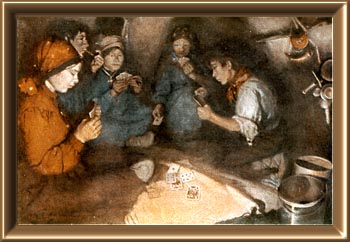 1903
also saw his first major exploratory expedition into the wilds.
For four months, by foot and dog sled he explored 1200 miles of
eastern Canadian wilderness. The experience and the material he
gleaned from it were the grist for a series of illustrated essays/stories
that ran in Scribner's in 1905 and an inspiration for the
rest of his life. At left is a plate from The Edge of the
Wilderness in the April issue. Another episode, Breaking
Trail, appeared in May. Both images are reproduced from
the printed source and can be compared with reproductions from
originals in Frank Schoonover - Illustrator of the North American
Frontier. Books and assignments flowed to him. He took every
opportunity to go "on location" to soak up the atmosphere
and local color. In fact, for all his obvious abilities, he apparently
found it easier to draw a subject which he was looking at than
to make one up. The Deliverance by Ellen Glasgow required
a trip to the tobacco fields of Virginia. Other early work necessitated
journeys to Denver, Butte, New Orleans, and anywhere he could
go "out West."
1903
also saw his first major exploratory expedition into the wilds.
For four months, by foot and dog sled he explored 1200 miles of
eastern Canadian wilderness. The experience and the material he
gleaned from it were the grist for a series of illustrated essays/stories
that ran in Scribner's in 1905 and an inspiration for the
rest of his life. At left is a plate from The Edge of the
Wilderness in the April issue. Another episode, Breaking
Trail, appeared in May. Both images are reproduced from
the printed source and can be compared with reproductions from
originals in Frank Schoonover - Illustrator of the North American
Frontier. Books and assignments flowed to him. He took every
opportunity to go "on location" to soak up the atmosphere
and local color. In fact, for all his obvious abilities, he apparently
found it easier to draw a subject which he was looking at than
to make one up. The Deliverance by Ellen Glasgow required
a trip to the tobacco fields of Virginia. Other early work necessitated
journeys to Denver, Butte, New Orleans, and anywhere he could
go "out West."
 He
maintained his studio at Pyle's school until 1906. By that time
he was a member of the Society of Illustrators, had his first
fiction published (both in 1905) and had traveled to Jamaica with
Pyle and Arthurs. In March 1906, he moved to his own studio in
Wilmington Delaware where he worked for the rest of his career.
He
maintained his studio at Pyle's school until 1906. By that time
he was a member of the Society of Illustrators, had his first
fiction published (both in 1905) and had traveled to Jamaica with
Pyle and Arthurs. In March 1906, he moved to his own studio in
Wilmington Delaware where he worked for the rest of his career.
And what a career! From 1903 to 1913 he was a regular contributor to all the great illustrated magazines of the day: Century, Harper's, McClure's, Scribner's, etc. He worked for Outing Magazine where he illustrated covers and the works of Jack London and Henry Van Dyke. Other famous authors whose stories and books he illustrated include Edgar Rice Burroughs (A Princess of Mars from 1917 at right), Rex Beach, Zane Grey, Robert W. Chambers, Gilbert Parker, Henry Van Dyke, etc. He was well known for his images for Clarence Mulford's Hopalong Cassidy stories.
At the time of Pyle's death in 1911, Schoonover was one of the premier illustrators of his day (the others were almost all Pyle students, too - most noticeably Wyeth and Parrish). In 1910 he and Arthurs had assisted Pyle on the Hudson County Courthouse Murals. He created wonderful color-plate books for Penn Publishing, including With Cortes the Conqueror (1917) and Joan of Arc (1918) as well as a series of war drawings (see sample below) done for the monthly Ladies' Home Journal. All these assignments certainly proved that he had learned to "make up" a picture.

For Harper's, he did a single illustration for each of the following titles. Each was used as dust jacket, onlaid color cover plate and frontispiece. Interior illustrations were in black and white and by Louis Rhead for most of the series.
| Tales From Shakespeare | 1918 |
| Arabian Nights Entertainment | 1921 |
| Grimm's Fairy Tales | 1921 |
| Kidnapped | 1921 |
| Robin Hood | 1921 |
| Robinson Crusoe | 1921 |
| Tom Brown's School Days | 1921 |
| Treasure Island | 1922 |
| King Arthur and His Knights | 1923 |
| Heidi | 1925 |
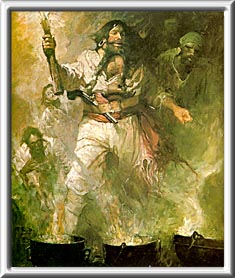 Following in the Pyle tradition
of historical subjects, he did three great biographical books
for Penn: Lafayette (1921), Washington (1925), and
Lincoln (1928) - all written by Lucy Foster Madison. Pyle's
piratical subjects may have influenced other titles including
Blackbeard Buccaneer (at left - reproduced in b&w
in the book) (1922), Privateers of '76 (1923), Barbary Bo
(1929), To Have and To Hold
(1931), Yankee Ships in Pirate Waters (1931) and Crimson
Cutlass (1933). There were dozens of other titles, most situated
in the wilds or focused around outdoor adventure, like The
Flamingo Feather and Ivanhoe (both 1923) and Sled
Trails and White Waters (1929). It's obvious to me that Schoonover
was following in his mentor's footsteps and would continue to
do so for his entire career. I can't think of another artist who
carried the Pyle banner as long and as proudly as he did.
Following in the Pyle tradition
of historical subjects, he did three great biographical books
for Penn: Lafayette (1921), Washington (1925), and
Lincoln (1928) - all written by Lucy Foster Madison. Pyle's
piratical subjects may have influenced other titles including
Blackbeard Buccaneer (at left - reproduced in b&w
in the book) (1922), Privateers of '76 (1923), Barbary Bo
(1929), To Have and To Hold
(1931), Yankee Ships in Pirate Waters (1931) and Crimson
Cutlass (1933). There were dozens of other titles, most situated
in the wilds or focused around outdoor adventure, like The
Flamingo Feather and Ivanhoe (both 1923) and Sled
Trails and White Waters (1929). It's obvious to me that Schoonover
was following in his mentor's footsteps and would continue to
do so for his entire career. I can't think of another artist who
carried the Pyle banner as long and as proudly as he did.
| aside: One of the interesting things about doing these pages is finding the connections that have escaped me over the years. I finally noticed the style and technique of Schoonover's line work is remarkably similar to that of J. Allen St. John and I'd guess that the influence went from St. John to Schoonover. By 1931, the date of Schoonover's drawing at right, St. John had been using the tortuously contoured line for a solid decade. Of course both of them could have shared the same influence of Anne Anderson or they could all have developed the approach independently. |
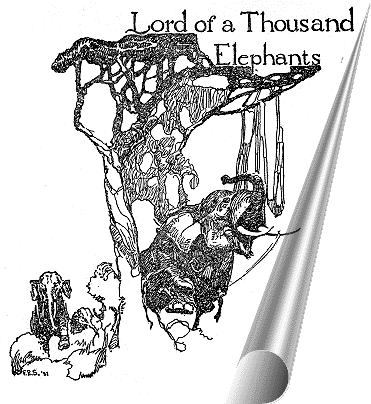 from Yankee Ships in Pirate Waters |
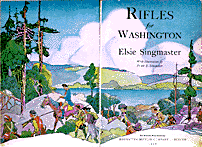 In 1931, his commercial output
was almost totally curtailed. That year, also in Pyle's footsteps,
he organized a School of Illustration (in Indianapolis,
Indiana) where he wrote the teaching texts and gave instructions
and lectures. In 1937, he devoted himself solely to easel painting
- mainly landscapes of the Delaware and Brandywine River valleys.
He was back to the fields and streams that had fascinated him
as a youth. The latest books I've seen from him are Roland
the Warrior (1934) and Rifles for Washington from 1938
(see right) which were both primarily line art.
In 1931, his commercial output
was almost totally curtailed. That year, also in Pyle's footsteps,
he organized a School of Illustration (in Indianapolis,
Indiana) where he wrote the teaching texts and gave instructions
and lectures. In 1937, he devoted himself solely to easel painting
- mainly landscapes of the Delaware and Brandywine River valleys.
He was back to the fields and streams that had fascinated him
as a youth. The latest books I've seen from him are Roland
the Warrior (1934) and Rifles for Washington from 1938
(see right) which were both primarily line art.
Unable to shrug off Pyle's influence, he started his own school in Wilmington in 1942 which lasted almost 25 years. If you're doing the math here, you'll realize that Schoonover had a long, productive life. A stroke in 1968 forced him to stop painting and to close the school. He died in 1972 at the age of 95, outliving even the venerable Parrish by six years.
The good folks at Frank E. Schoonover, Fund, Inc. asked that I post the following:
From 1940 until just before his death in 1972, Schoonover concentrated on painting landscapes of the Brandywine and Delaware River valleys. He also formed and taught in his own School of Art at his studios at 1616 N. Rodney Street in Wilmington. He had hundreds of devoted students over those years and some are fine artists in their own right. He also painted portraits and designed beautiful stained glass windows, 15 of which are in Immanuel Church on 17th Street in Wilmington. Schoonover painted until age 91 and went on to visit and assist some of his students with their work until his death at age 95 in 1972.
A catalogue raisonne is being compiled of his 2500+ works. To find out more about that project and current Schoonover information, please visit their website www.schoonoverfund.org.

To learn more about Frank E. Schoonover, see:
| The Illustrator in America 1900-1960's | Walt Reed, 1966 Reinhold |
| The Brandywine Tradition | Henry C. Pitz, 1968 Houghton Mifflin |
| Howard Pyle - Writer, Illustrator, Founder of the Brandywine School | Henry C. Pitz, 1975 Clarkson & Potter |
| Frank Schoonover - Illustrator of the North American Frontier | Cortlandt Schoonover, 1976 Watson-Guptill |
| 200 Years of American Illustration | Henry C. Pitz, 1977 Random House |
| Frank E. Schoonover Illustrator | Ann Barton Brown, 1979 Brandywine River Museum |
| The Illustrator in America 1880-1980 | Walt and Roger Reed, 1984 Madison Square Press |
| The Vadeboncoeur Collection of Knowledge | Jim Vadeboncoeur, Jr. 1998 |
| The Vadeboncoeur Collection of ImageS 3 | Jim Vadeboncoeur, Jr. 2002 JVJ Publishing |
|
Illustrations are copyright by their
respective owners. This page written, designed & © 1998 by Jim Vadeboncoeur, Jr. Updated 2011. |
